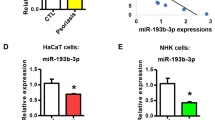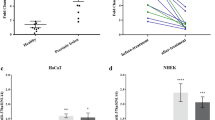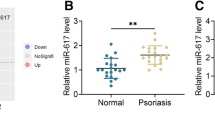Abstract—
Psoriasis is a common, chronic, and relapsing skin disease characterized by hyperproliferation of keratinocytes and apoptosis delay. However, the molecular mechanisms underlying the progression of psoriasis remain elusive. MicroRNAs (miRNAs) are single-stranded, small non-coding RNAs that play a crucial role in the development of psoriasis by promoting targeted mRNA degradation or translational inhibition. Here, we report that miR-214-3p, one of the downregulated miRNAs identified in the skin of psoriatic patients and imiquimod (IMQ)-induced mouse models, can negatively regulate the expression of forkhead box M1 (FOXM1). miR-214-3p inhibition leads to hyperproliferation and increased apoptosis of keratinocytes in vitro. Moreover, we show that miR-214-3p inhibition causes an arrest of the cell cycle at the S stage by elevating the expression of NEK2, KIF20A, CENP-A, CENP-F, and Cyclin B1 and by reducing the expression of Cyclin D1 in HaCaT cells. In vivo, the administration of miR-214-3p attenuates the psoriasis-like phenotype in IMQ-induced mice. Collectively, our results suggest that miR-214-3p/FOXM1 axis in keratinocytes could be a novel target in the treatment of psoriasis.





Similar content being viewed by others
AVAILABILITY OF DATA AND MATERIAL
All data generated or analyzed during this study are available upon reasonable request.
CODE AVAILABILITY
Not applicable.
References
Boehncke, W.-H., and M.P. Schön. 2015. Psoriasis. The Lancet 386 (9997): 983–994.
Lowes, M.A., M. Suarez-Farinas, and J.G. Krueger. 2014. Immunology of psoriasis. Annual Review of Immunology 32: 227–255.
Cai, Y., et al. 2011. Pivotal role of dermal IL-17-producing gammadelta T cells in skin inflammation. Immunity 35 (4): 596–610.
Tan Gana, N.H., A.F. Victoriano, and T. Okamoto. 2012. Evaluation of online miRNA resources for biomedical applications. Genes Cells 17 (1): 11–27.
Bhaskaran, M., and M. Mohan. 2014. MicroRNAs: History, biogenesis, and their evolving role in animal development and disease. Veterinary Pathology 51 (4): 759–774.
Zhang, T., et al. 2017. MicroRNA-4530 promotes angiogenesis by targeting VASH1 in breast carcinoma cells. Oncology Letters 14 (1): 111–118.
Yang, X., et al. 2011. miR-21 promotes keratinocyte migration and re-epithelialization during wound healing. International Journal of Biological Sciences 7 (5): 685–690.
Xu, N., et al. 2011. MiR-125b, a MicroRNA downregulated in psoriasis, modulates keratinocyte proliferation by targeting FGFR2. Journal of Investigative Dermatology 131 (7): 1521–1529.
Wu, R., et al. 2018. MicroRNA-210 overexpression promotes psoriasis-like inflammation by inducing Th1 and Th17 cell differentiation. Journal of Clinical Investigation 128 (6): 2551–2568.
Li, D., et al. 2015. MicroRNA-31 promotes skin wound healing by enhancing keratinocyte proliferation and migration. Journal of Investigative Dermatology 135 (6): 1676–1685.
Yan, S., et al. 2015. NF-kappaB-induced microRNA-31 promotes epidermal hyperplasia by repressing protein phosphatase 6 in psoriasis. Nature Communications 6: 7652.
Lerman, G., et al. 2014. The crosstalk between IL-22 signaling and miR-197 in human keratinocytes. PLoS One 9 (9): p. e107467.
Yu, Z., et al. 2020. High-throughput transcriptome and pathogenesis analysis of clinical psoriasis. Journal of Dermatological Science 98 (2): 109–118.
Raaby, L., et al. 2015. Changes in mRNA expression precede changes in microRNA expression in lesional psoriatic skin during treatment with adalimumab. British Journal of Dermatology 173 (2): 436–447.
Kelleher, Fergal C., and H.O.S., . 2015. FOXM1 in sarcoma: Role in cell cycle, pluripotency genes and stem cell pathways. Oncotarget 7 (207): 42792–42804.
Kahlenberg, M.S., et al. 2003. Molecular prognostics in colorectal cancer. Surgical Oncology 12 (3): 173–186.
Samowitz, W.S., et al. 2000. Relationship of Ki-ras mutations in colon cancers to tumor location, stage, and survival: A population-based study. Cancer Epidemiology Biomarkers and Prevention 9 (11): 1193–1197.
Kluftinger, A.M., et al. 1992. Correlation of epidermal growth factor receptor and c-erbB2 oncogene product to known prognostic indicators of colorectal cancer. Surgical Oncology 1 (1): 97–105.
Kountourakis, P., et al. 2006. Clinicopathologic significance of EGFR and Her-2/neu in colorectal adenocarcinomas. Cancer Journal 12 (3): 229–236.
Pereira, C.B.L., et al. 2013. Prognostic and predictive significance of MYC and KRAS alterations in breast cancer from women treated with neoadjuvant chemotherapy. PLoS ONE 8 (3).
Banin Hirata, B.K., et al. 2014. Molecular markers for breast cancer: prediction on tumor behavior. Disease Markers 2014.
Yang, P., et al. 2013. The impact of p53 in predicting clinical outcome of breast cancer patients with visceral metastasis. Scientific Reports 3.
Jaiswal, N., S. Chakraborty, and A. Nag. 2014. Biology of FOXM1 and its emerging role in cancer therapy. J Proteins Proteomics 5: 1–24.
Tian, S., et al. 2012. Meta-analysis derived (MAD) transcriptome of psoriasis defines the "core" pathogenesis of disease. PLoS One 7 (9): p. e44274.
Xu, M., et al. 2018. An interleukin-25-mediated autoregulatory circuit in keratinocytes plays a pivotal role in psoriatic skin inflammation. Immunity 48 (4): 787-798.e4.
Lili Jiang, Q.H. 2010. Siyang Zhang, Hsa-miR-125a-3p and hsa-miR-125a-5p are downregulated in non-small cell lung cancer and have inverse effects on invasion and migration of lung cancer cells. BMC Cancer 10 (318): 13.
Yin, F., et al. 2015. MiR-125a-3p regulates glioma apoptosis and invasion by regulating Nrg1. PLoS One 10(1): p. e0116759.
Hisaoka, M., et al. 2011. Identification of altered MicroRNA expression patterns in synovial sarcoma. Genes Chromosomes and Cancer 50 (3): 137–145.
Xu, X., et al. 2011. Microarray-based analysis: Identification of hypoxia-regulated microRNAs in retinoblastoma cells. International Journal of Oncology 38 (5): 1385–1393.
Swindell, W.R., et al. 2015. Psoriasis drug development and GWAS interpretation through in silico analysis of transcription factor binding sites. Clinical and Translational Medicine 4: 13.
Halasi, M., and A.L. Gartel. 2013. FOX(M1) news–it is cancer. Molecular Cancer Therapeutics 12 (3): 245–254.
Madureira, P.A., et al. 2006. The Forkhead box M1 protein regulates the transcription of the estrogen receptor alpha in breast cancer cells. Journal of Biological Chemistry 281 (35): 25167–25176.
Funding
This work was supported by the National Key Research and Development Project (2018YFC1705304) and Scientific Research Program of Wuhan Municipal Health Commission (WX21A13).
Author information
Authors and Affiliations
Contributions
Jin Zhao: conceptualization, methodology, software. Fei Wang: conceptualization, methodology, software. Qingjun Tian: methodology. Jing Dong: methodology. Liuqing Chen: supervision. Rongyi Hu: writing—reviewing and editing. Jin Zhao and Fei Wang contributed equally to this article; both of them are first authors.
Corresponding authors
Ethics declarations
Ethics Approval
All animal experiments were approved under the guidelines of the Animal Experimental Ethics Committee of the Hubei University of Chinese Medicine.
Concent to Participate
Not applicable.
Concent for Publication
Not applicable.
Conflict of Interest
The authors declare no competing interests.
Additional information
Publisher's Note
Springer Nature remains neutral with regard to jurisdictional claims in published maps and institutional affiliations.
Supplementary Information
Below is the link to the electronic supplementary material.
Rights and permissions
About this article
Cite this article
Zhao, J., Wang, F., Tian, Q. et al. Involvement of miR-214-3p/FOXM1 Axis During the Progression of Psoriasis. Inflammation 45, 267–278 (2022). https://doi.org/10.1007/s10753-021-01544-6
Received:
Accepted:
Published:
Issue Date:
DOI: https://doi.org/10.1007/s10753-021-01544-6




